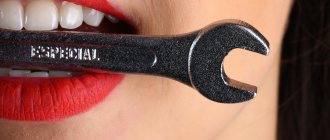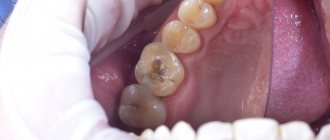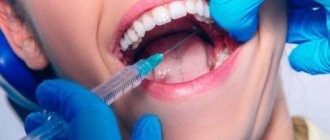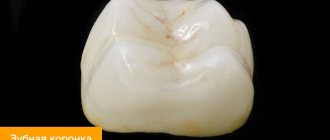June 15, 2019
Many patients are interested in the question of how to remove a crown from a tooth, because essentially the structure is permanent. However, this just means that the owner himself cannot remove it from the mouth, but the dentist, using tools and specialized equipment, will do this without difficulty. Today you will learn about how this process goes, by what methods the final result is achieved, what nuances await patients during the procedure of removing a crown from a tooth from an article prepared by journalists from the editorial office of the UltraSmile.ru portal.
What are the ways to remove a crown?
When is it necessary to remove a crown from a tooth?
Removing the crown from a tooth needs to be done only when there is a serious need for it, because the crown itself can be used for 7-10 years or more (the time period depends on the material from which the prosthesis was made).
Let us list the reasons why it is necessary to resort to such manipulation:
- a disease has developed under the structure: for example, secondary caries, periodontitis or a cyst,
- errors made at one of the stages of prosthetics: perhaps the crown does not correspond to the individual characteristics of the patient, is poorly installed and adjusted, is made of low-quality materials,
- the patient’s desire to replace the structure with a prosthesis made of a better and more beautiful material: for example, replace a metal or metal-plastic product with metal ceramics or zirconium dioxide,
- injuries that led to damage and breakage of an artificial tooth,
- destruction of permanent cement on which the orthopedic structure was fixed,
- The product has expired.
The reason for removal may be the development of caries under the crown.
If the tooth under the crown hurts, there is a bad smell, and the structure has become shaky and movable, then it is time to visit a dentist, who, based on an examination and x-ray, will decide on the need to remove and replace the artificial material.
According to numerous studies, the need to prematurely remove crowns already in the first years of use in 40% of all cases arises due to the fact that poor-quality endodontic treatment and poor-quality sanitation of the oral cavity were performed before preparing for prosthetics.
All of the above reasons are a serious reason to think about removing the prosthetic structure. Naturally, first you need to go to an appointment with a dentist, who will explain how crowns are removed from teeth. And we will look at the methods that exist today.
All
Fixed prosthetics
- Crowns
- Metal-ceramic crowns
- Metal-free crowns
- All-ceramic crowns
- Crowns based on zirconium oxide
- Temporary crowns
- Microprosthetics (tabs)
- Veneers
- Hollywood veneers (Lumineers)
Removable prosthetics
- Complete removable dentures
- Partially removable dentures
- Partially removable dentures made of plastic
- Clasp dentures
Method No. 1: sawing with a boron
So, let's figure out whether it is possible to remove a crown with permanent cement.
The method of removal using boron is the oldest and by far the most unaesthetic. This means that after using this tool, the sawn artificial material will only have to be thrown into the trash bin, because it can no longer be used for its intended purpose, that is, it will no longer be possible to re-prosthetize a tooth with it.
The technique is simple, cheap and quite effective, but it must be used by a doctor who has a high level of professionalism, because the approach requires caution and precision. An inexperienced specialist may damage the tooth itself or the soft tissue around it during the dismantling process.
With this method, it will not be possible to reuse the crown
“We removed the crown from the tooth with a regular bur and simply sawed it in half. There’s nothing terrible, but when the material got very hot, the smell, I’ll tell you, was not very good, plus there were slightly painful and uncomfortable sensations, even despite the fact that I had been given anesthesia before this, and the tooth itself had been under the prosthesis for a long time depulped!"
Mari, review from 32top.ru
This method is used if the patient has dentures made of inexpensive materials, which he would not mind disposing of later. The method is also suitable if the artificial structure itself is mobile or wobbly. Then it is simply sawed to the teeth, then, using special tools, the resulting edges are carefully bent in different directions and removed.
Reviews
Dental prosthetics is not the cheapest service provided by dental clinics. Therefore, before the procedure, it would be useful to approach the search for an experienced doctor with special care.
This will help avoid unforeseen situations when, due to mistakes made during installation, re-prosthetics cannot be avoided.
If after reading the article you would like to share your own opinion on this topic, leave your comment below.
If you find an error, please select a piece of text and press Ctrl+Enter.
Tags: dental crowns, fixed dentures, removal of a crown from a tooth
Did you like the article? stay tuned
Previous article
The essence of using individual zirconium abutments
Next article
The use of an angular abutment to achieve high aesthetic prosthetics
Method No. 2: using ultrasound
Are you wondering how to remove a crown from permanent cement in one of the safest and most innovative ways, and without causing any damage to it? Then ask your dentist if it is possible to use ultrasound in your case. Through impulses, the doctor acts on the cement composition, which gradually cracks. The specialist moves along the “tooth-crown” boundary; under the influence of vibrations, the cement is destroyed.
The product can be removed using ultrasound
The procedure really allows you to remove the structure in its original form, but it has a number of disadvantages. First, ultrasound has a rather gentle effect, so it is not always possible to achieve the goal the first time, and sometimes you have to visit the doctor several times. Secondly, only products that are made from not very dense materials are amenable to hardware exposure to sound waves. For example, it will not be possible to remove structures made using glass ionomers using ultrasound. Third, vibrations may be unpleasant for the patient.
Method No. 4: Kop (Koch) apparatus
This is a tool that again has a hook at the end. However, the device is not launched mechanically, but using a button, which breaks the cement along the edge of the crown using small shocks or a shock wave, after which the structure begins to move from its place. Next, the doctor can only use special forceps that hook and help to finally remove the prosthesis.
See what the Koch apparatus for removing crowns looks like in the photo.
This is what the Koch apparatus for removing crowns looks like
This device is more convenient and efficient than a manual device; it allows you to remove the product with virtually no damage and “works” quickly. However, it also has disadvantages. In particular, many patients note that during the procedures they feel “twitching” and discomfort. Also, some people are very concerned about the noise that the device makes. There is one more drawback - the device can damage the ceramic coating of the crown, leaving chips and cracks, and then the structure will have to be restored.
Kinds
Full
Complete – covers the tooth surface completely. Can be made using stamping from preliminary blanks. This method is rarely used. The one-piece manufacturing method is more often used. The monolith repeats the anatomy of its tooth. The technology is imperfect due to the need for preparation.
Half crown
Half-crown - a partial crown is a non-removable structure that covers the tooth on four surfaces: oral, lateral and incisal. The buccal or labial surface remains free. This type of crown is placed on premolars and front teeth. Another name is three-quarter, although in fact the product covers 4/5 of the tooth surface.
The structure can be used as a supporting element of a prosthesis (bridge, brugel) or as part of a splint.
Equatorial
Equatorial – covers the crown part of the tooth. This type is used when erasing enamel, as a support for splinting and as an element of bridge prostheses.
Stump
A stump crown is a deep structure for restoring a completely or partially destroyed tooth.
With metal-ceramic coating
Gold crown with metal-ceramic coating. The method is based on the production of a frame made of gold, which is covered with ceramic mass. This is done primarily for aesthetic purposes.
Pin
A crown on a pin is installed in case of complete loss of a tooth. The base, frame or entire prosthesis can be made of gold with or without a metal-ceramic coating.
Method No. 5: using the Coronaflex device
The device looks like a pistol, and its operating principle is based on compressed air, which escapes from the device under pressure and breaks the cement. At the same time, this device does not have any negative effect on the artificial material of the structure or on the soft tissues of the patient.
The Coronaflex device is not available in every dentist today, so the procedure with it will be more expensive compared to other methods. However, it makes sense to use the device if you have a zirconium dioxide crown, which can be reinstalled after, for example, the tooth under the structure is cured. In addition, the procedure using this device is more comfortable, safer, and requires less time to solve the problem. Also, according to patient reviews, the device makes virtually no noise, which allows you to feel comfortable in the dentist’s chair.
The Coronaflex device removes the crown quite comfortably
Stages of orthopedic installation removal
The process of dismantling a fixed prosthesis consists of the following steps:
- preparation: an orthopedic dentist examines the patient’s entire oral cavity and the problem area in particular, assesses their condition and comes up with a work plan,
- removal: the doctor and the patient decide on the method and the crown is dismantled,
- diagnostics: the doctor evaluates the integrity of the removed installation, and also carefully examines the condition of the tooth root on which the detached structure was supported. The place for subsequent fixation of the prosthesis is treated with antiseptics (and if necessary, therapeutic measures are carried out, during which the patient is given a temporary plastic crown),
- fixation: if the prosthesis was not deformed during removal, it is ready for reinstallation. Otherwise, you will have to wait until it is restored or a new crown is made. True, you will have to carry out several fittings and be sure to take into account the shape of the treated tooth - it is important that it completely coincides with the internal cavity of the crown,
- recovery: to avoid possible complications, the patient receives from the doctor a list of instructions for easy rehabilitation. At first, it is important to follow a special gentle diet.
Is it possible to remove a crown at home?
If you are interested in the question of how to remove a crown from a tooth at home, then the answer will be clear: you cannot do this at home. This procedure should only be performed by a professional dentist. For those who neglect this rule, everything can end sadly: there is a risk of damaging not only the artificial material, but also injuring the soft tissues and the tooth itself, which is located under the crown.
You can try to remove the structure yourself only if it has come unstuck and started to loosen, or if it has fallen apart or split, and there is a need to remove the remaining fragments of the product, which can injure the mucous membrane or antagonist teeth. But it’s better if you rush to see a dentist even in such situations.
If the structure comes unstuck, you can remove it yourself
If the materials from which the crown was created, as well as the cement, have expired, and you do not rush to the dentist, then an unpleasant situation may await you. For example, artificial material can be swallowed. What to do in such situations, read the material “5 useful tips for those who have swallowed a crown.”
Is it possible to cure a tooth without removing the crown?
The question is very relevant, because usually, after removing a structure, it can rarely be reused for its intended purpose, therefore, you have to pay money for the manufacture and installation of a new prosthesis. Fortunately, today in some cases you can do without removing the structure. For example, if it is necessary to cure recurrent caries or remove a small cyst, the doctor may perform endodontic manipulations through a small hole made in the crown or through an incision in the gum (to remove the cyst). After the procedures, this hole will be masked with a composite material, and the sutured gum will need time to heal.
In some cases, modern technologies make it possible to cure a tooth without removing the crown.
However, you need to understand that in order to safely and effectively carry out such jewelry manipulations, the doctor must be a professional. In addition, the patient himself should seek help when the problem is still minor and the inflammatory process has not gone too far. To do this, it is necessary to undergo preventive examinations, because the more minor the problem, the easier it is to solve it with therapeutic methods, without resorting to drastic measures.
Notice
: Undefined variable: post_id in
/home/c/ch75405/public_html/wp-content/themes/UltraSmile/single-item.php
on line
45 Notice
: Undefined variable: full in
/home/c/ch75405/public_html/wp-content /themes/UltraSmile/single-item.php
on line
46
Rate this article:
( 6 ratings, average: 5.00 out of 5)
crown
- Lutskaya I.K., Zinovenko O.G. Frequency of development of caries in teeth covered with artificial crowns.
Indications for removing structures
Fixing a dental crown or bridge, which is fixed on two supporting units (these can be implants), is a slow and quite labor-intensive process. In a good way, a well-installed design and compliance with all the rules of oral care, professional hygiene every six months allow them to remain in their proper place for a long time - 10, 15 years, or even longer. In any case, the reasons for early removal of a crown or bridge must be serious. Let's take a closer look at them.
Only until December 25 South Korean implant Osstem - from 18,500 rubles.
Hurry up to sign up for a free consultation and lock in promotional prices.
Call now or request a call
Opening hours: 24 hours a day - seven days a week
Pain and destruction of supporting teeth
It happens that a tooth hidden under the cover of a prosthesis begins to bother its owner and hurt. In this case, the person complains not only of pain, but also of an unpleasant putrid odor from the mouth, more precisely, from under the structure (according to science - halitosis). There are several reasons: the root of the covered unit has become infected, caries is progressing, sometimes pulpitis or a cyst has appeared.
If the doctor is unable to reach the site of the lesion, he needs to remove the prosthesis (or the entire bridge structure), that is, completely saw and remove it.
However, you can relieve a person from pain and cure a tooth using a workaround. So, the doctor can drill a hole in the desired area of the crown and perform treatment through it. At the end of the therapeutic measures, the formed cavity is closed with composite materials. But it is important to understand that such a treatment method, which protects the patient from dismantling a non-removable product, shortens the life of the structure. In addition, it cannot always be applied.
Poor installation
It happens that the fixation of orthopedic products was not carried out properly by the doctor. Or, over time, the prosthesis itself has lost its stability. Here are the most common reasons why this can happen:
- mistakes made by an inexperienced doctor when fixing the base of the prosthesis,
- The prosthesis initially does not fit tightly,
- the design of the crown does not coincide with the bite, that is, it causes pain when closing the jaws,
- the cement turned out to be of dubious quality,
- the integrity of the connecting filling layer at the junction points is compromised.
It is not difficult to understand that a crown or bridge is no longer firmly in place. This will be indicated by symptoms such as their staggering, swaying and mobility, especially obvious during a meal or conversation.
Gum problems
Our soft tissues that “cover” the jaw bones can suffer due to various circumstances. The most typical cause is inflammation caused by poor oral hygiene. Caries, damage to the mucous membrane and even prolonged stress1 can cause redness and swelling of the gums (gingivitis). It happens that periodontal tissues are injured due to an unscrupulous approach to the manufacture and installation of the product. If it rubs the free gum, it provokes the development of inflammation. And this is a direct indication for the elimination of the removable structure, and the soft tissues themselves will require therapy.
Violation of aesthetics
It happens that the patient does not have dental indications for removing orthopedic installations. The products do not cause problems to a person, they are intact, without chips or cracks (in the latter case, repairs are sometimes possible, but more often liquidation of the devices is required). And yet, a person still sits in the orthopedic chair in order to dismantle the prostheses. Often this is dictated by the desire to update old structures. It happens that they are subject to deformation and lose their aesthetics. Often we are talking about the desire to replace orthopedic products with more modern, high-quality and durable analogues.
Complex on 4 OSSTEM implants with delayed loading - from RUB 170,000.
Complex implantation Osstem (South Korea) with delayed loading after 4-6 months.
Guarantee for the doctor’s work - unlimited Call now or order a call
Opening hours: 24 hours a day - seven days a week
Comments
Good afternoon. My metal-ceramic bridge on one tooth became movable. It is possible to remove the bridge without damage in order to reuse it. Thank you.
Svetlana (06/18/2019 at 11:25 am) Reply to comment
- Dear Svetlana! As a rule, no, the bridge is completely removed (you need to saw it). In addition, it is fixed on at least 2 supporting teeth, which apparently have become unusable.
Editorial staff of the portal UltraSmile.ru (06/21/2019 at 12:23 pm) Reply to comment
Tell me, how do you remove the crown from the implant?
AlinaR. (06/22/2019 at 17:29) Reply to comment
- Dear Alina! There are two extraction methods here, and which one to use will depend on how the crown is attached to the implant. If the fixation was screw (which is more preferable), then the doctor will simply unscrew the screws connecting the crown, implant and abutment. If the fixation was cement, then the specialist will use the cutting method - others are not suitable for implantation.
Editorial staff of the portal UltraSmile.ru (06/25/2019 at 09:19) Reply to comment
Which doctor should I go to to have my crown removed?
Makar (06/30/2019 at 10:02 pm) Reply to comment
- Dear Makar! This manipulation should be performed by an orthopedic dentist.
Editorial staff of the portal UltraSmile.ru (07/03/2019 at 09:17) Reply to comment
Is this procedure, removing a crown from a tooth, painful?
Arfa (07/18/2019 at 04:47 pm) Reply to comment
- Good afternoon This procedure cannot be called pleasant and comfortable, but it is painless, because... the doctor applies anesthesia. In addition, in most cases, crowns are used to replace already pulpless teeth that do not have a nerve. Pain and discomfort can only occur if inflammation has begun under the crown. Then pain can be felt not only in the tooth itself, but also in the soft tissues surrounding it.
Editorial staff of the portal UltraSmile.ru (07/26/2019 at 09:33) Reply to comment
Will my tooth hurt after the crown is removed?
Vedeneeva Victoria (05.08.2019 at 19:05) Reply to comment
- Dear Victoria. A tooth can only hurt if it has developed periodontitis or granuloma. Less often, pain occurs because the crown removal procedure was carried out by a not very professional doctor, who could injure the gums or mucous membranes, or damage the tooth itself.
Editorial staff of the portal UltraSmile.ru (08.08.2019 at 09:25) Reply to comment
Tell me, what if the crowns do not fit tightly to the gums on the back side, where is the palate? is this normal? that is, the tricrowns on the right entered the cast gums; three crowns _and the other three on the back side I feel their edges with my tongue….
san (01/09/2021 at 04:13) Reply to comment
a metal-ceramic bridge costs 10 months on one side it moves away and sways I was at the doctor’s appointment and the answer was swing the entire bridge and come what to do
Natalia (09.12.2021 at 18:51) Reply to comment
Write your comment Cancel reply
What to do after removing the structure
If the doctor finds an inflammatory process at the site of the removed crown or bridge, therapy will be required in accordance with the cause that caused it (caries, pulpitis, gingivitis, periodontitis, etc.). Accordingly, treatment is first carried out, after which the shape of the tooth is restored, impressions are taken again and a new prosthesis is created (or the old one is returned to its place - if possible).
But it happens that after dismantling the structure, the patient experiences discomfort or even pain. To establish the cause, the doctor needs to carefully examine the tooth and surrounding tissues and assess their condition - this requires an x-ray. It will show the quality of the filled canals and the condition of the structures surrounding the tooth. It happens that the tissues under the crown have changed irreversibly and can no longer be restored. Then repeated prosthetics becomes impossible, the tooth will need to be removed. And you can think about alternatives to prosthetics: installing a bridge or an implant.
- The influence of stress on the condition of the tissues of the maxillofacial area. / Korenevskaya N. A., Gorodetskaya I. V. Journal “Bulletin of Vitebsk State Medical University”. 2009
- Study of the process of removing dentures by destroying the fixing cement under ultrasonic influence. / Kiselev M. G. Vertinskaya A. P. Journal “Science and Technology”. 2007
Author: Chernov A. R. (Thank you for your help in writing the article and the information provided)
Stock
-17%
Quadrotti dentures (without palate) 60,000 rub.
50,000 rub.
get -27 %
Teeth in 1 day on Straumann implants using ProArch technology!
300,000 rub. 220,000 rub.
get -25 %
Removable denture for 1 jaw 40,000 rub.
30,000 rub.
get -11 %
Segment of chewing teeth with prosthesis on day 3 135,000 rub.
120,000 rub. get
Rehabilitation period
If necessary, the doctor will prescribe medications and painkillers. It is equally important to follow a number of rules for the first 3-4 days that will prevent the development of complications:
- Do not rinse your mouth.
- Do not chew or brush your teeth on the extraction side.
- Do not take a hot bath or visit a bathhouse or sauna.
- Do not engage in sports or heavy physical labor.
- Avoid air travel (especially if the operation was on the upper jaw).
2-3 days after removal you should come for a follow-up examination, and after 5 days the sutures are removed.
To the list of posts











